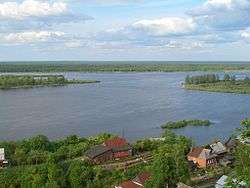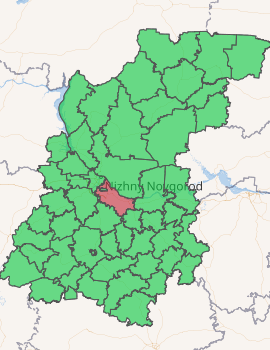Kstovsky District
Kstovsky District (Russian: Ксто́вский райо́н) is an administrative district (raion), one of the forty in Nizhny Novgorod Oblast, Russia.[1] Municipally, it is incorporated as Kstovsky Municipal District.[4] It is located in the center of the oblast. The area of the district is 1,225 square kilometers (473 sq mi).[1] Its administrative center is the town of Kstovo.[1] Population: 112,823 (2010 Census);[2] 46,759 (2002 Census);[6] 47,917 (1989 Census).[7] The population of Kstovo accounts for 59.1% of the district's total population.[2]
Kstovsky District Кстовский район | |
|---|---|
 A view of the Volga River from the selo of Bezvodnoye in Kstovsky District | |
.png) Flag  Coat of arms | |

Location of Kstovsky District in Nizhny Novgorod Oblast | |
| Coordinates: 56°09′06″N 44°11′44″E | |
| Country | Russia |
| Federal subject | Nizhny Novgorod Oblast[1] |
| Established | 1929[1] |
| Administrative center | Kstovo[1] |
| Area | |
| • Total | 1,225 km2 (473 sq mi) |
| Population | |
| • Total | 112,823 |
| • Estimate (2018)[3] | 121,877 (+8%) |
| • Density | 92/km2 (240/sq mi) |
| • Urban | 59.1% |
| • Rural | 40.9% |
| Administrative structure | |
| • Administrative divisions | 1 Towns of district significance, 13 Selsoviets |
| • Inhabited localities[1] | 1 Cities/towns, 121 Rural localities |
| Municipal structure | |
| • Municipally incorporated as | Kstovsky Municipal District[4] |
| • Municipal divisions[4] | 1 Urban settlements, 13 Rural settlements |
| Time zone | UTC+3 (MSK |
| OKTMO ID | 22637000 |
| Website | http://www.kstovo-adm.ru |
Geography
Kstovsky District is located along the southern shore of the Volga River. The westernmost part of the district is adjacent to the city of Nizhny Novgorod. It is gradually becoming more suburban, its housing developments and shopping centers closely linked to the life of the city. The east of the district is more rural, with potato, root crops, and grain fields and cattle pastures alternating with forests and dacha areas.
History
The district was established in 1929 and given its present name in 1930.[1]
Culture
Local historical sites include the Church of Our Lady of Kazan in the village of Veliky Vrag, just northeast of Kstovo. It was built in 1792 and is now protected as a heritage site, owned by the federal government.[8][9]
Economy
Most of the industry in the district is located in and around the town of Kstovo. The rest of the district is mostly agricultural, although the metalworking plant in Bezvodnoye and a brick factory in Afonino are well known in the region.
The construction of Gorky Nuclear District Heating Plant, which was meant to provide heating for a large part of Nizhny Novgorod, was started in the early 1980s in the western part of the district, near the Royka railway station and the village of Fedyakovo. A few years later, after the Chernobyl disaster, the construction stopped, and the large, almost completed building remains, as of 2006, mostly unused.
One of Nizhny Novgorod metropolitan area's largest shopping malls, anchored by an IKEA store and an Auchan hypermarket, is located near the same Fedyakovo, across the road from the uncompleted nuclear plant building. Located near both Nizhny Novgorod and Kstovo, the mall is connected to both cities by free shuttle buses.
References
Notes
- Order #3-od
- Russian Federal State Statistics Service (2011). "Всероссийская перепись населения 2010 года. Том 1" [2010 All-Russian Population Census, vol. 1]. Всероссийская перепись населения 2010 года [2010 All-Russia Population Census] (in Russian). Federal State Statistics Service.
- "26. Численность постоянного населения Российской Федерации по муниципальным образованиям на 1 января 2018 года". Federal State Statistics Service. Retrieved January 23, 2019.
- Resolution #670
- "Об исчислении времени". Официальный интернет-портал правовой информации (in Russian). June 3, 2011. Retrieved January 19, 2019.
- Russian Federal State Statistics Service (May 21, 2004). "Численность населения России, субъектов Российской Федерации в составе федеральных округов, районов, городских поселений, сельских населённых пунктов – районных центров и сельских населённых пунктов с населением 3 тысячи и более человек" [Population of Russia, Its Federal Districts, Federal Subjects, Districts, Urban Localities, Rural Localities—Administrative Centers, and Rural Localities with Population of Over 3,000] (XLS). Всероссийская перепись населения 2002 года [All-Russia Population Census of 2002] (in Russian).
- "Всесоюзная перепись населения 1989 г. Численность наличного населения союзных и автономных республик, автономных областей и округов, краёв, областей, районов, городских поселений и сёл-райцентров" [All Union Population Census of 1989: Present Population of Union and Autonomous Republics, Autonomous Oblasts and Okrugs, Krais, Oblasts, Districts, Urban Settlements, and Villages Serving as District Administrative Centers]. Всесоюзная перепись населения 1989 года [All-Union Population Census of 1989] (in Russian). Институт демографии Национального исследовательского университета: Высшая школа экономики [Institute of Demography at the National Research University: Higher School of Economics]. 1989 – via Demoscope Weekly.
- Соглашение между Правительством РФ и администрацией Нижегородской области №10 от 8 июня 1996 г. «О разграничении полномочий в сфере управления объектами исторического и культурного наследия, находящимися в государственной собственности». (Agreement Between the Government of the Russian Federation and the Administration of Nizhny Novgorod Oblast #10 of June 8, 1996 On the Separation of Powers in the Area of Management of State-Owned Historical and Cultural Heritage Sites. ).
- Президент Российской Федерации. Указ №176 от 20 февраля 1995 г. «Об утверждении Перечня объектов исторического и культурного наследия федерального (общероссийского) значения». Вступил в силу 7 марта 1995 г.. Опубликован: "Собрание законодательства РФ", 27 февраля 1995 г.. (President of the Russian Federation. Decree #176 of February 20, 1995 On the Approval of the Registry of the Historical and Cultural Heritage Sites of Federal (All-Russian) Significance. Effective as of March 7, 1995.).
Sources
- Государственно-правовой департамент Нижегородской области. Приказ №3-од от 27 января 2016 г. «Об утверждении реестра административно-территориальных образований, городских и сельских населённых пунктов Нижегородской области». Опубликован: "Нижегородская правда", №27(26048) (начало) и №30 (26051) (окончание), 19 и 26 марта 2016 г. (State Legal Department of Nizhny Novgorod Oblast. Order #3-od of January 27, 2016 On the Adoption of the Registry of the Administrative-Territorial Formations, Urban and Rural Localities of Nizhny Novgorod Oblast. ).
- Правительство Нижегородской области. Постановление №670 от 11 сентября 2009 г. «О перечне муниципальных образований Нижегородской области», в ред. Постановления №587 от 29 августа 2014 г. «О внесении изменений в перечень муниципальных образований Нижегородской области, утверждённый Постановлением Правительства Нижегородской области от 11 сентября 2009 г. №670». Опубликован: "Нижегородские новости", №177(4309), 1 октября 2009 г. (Government of Nizhny Novgorod Oblast. Resolution #670 of September 11, 2009 On the Registry of the Municipal Formations of Nizhny Novgorod Oblast, as amended by the Resolution #587 of August 29, 2004 On Amending the Registry of the Municipal Formations of Nizhny Novgorod Oblast, Adopted by Resolution #670 of the Government of Nizhny Novgorod Oblast of September 11, 2009. ).